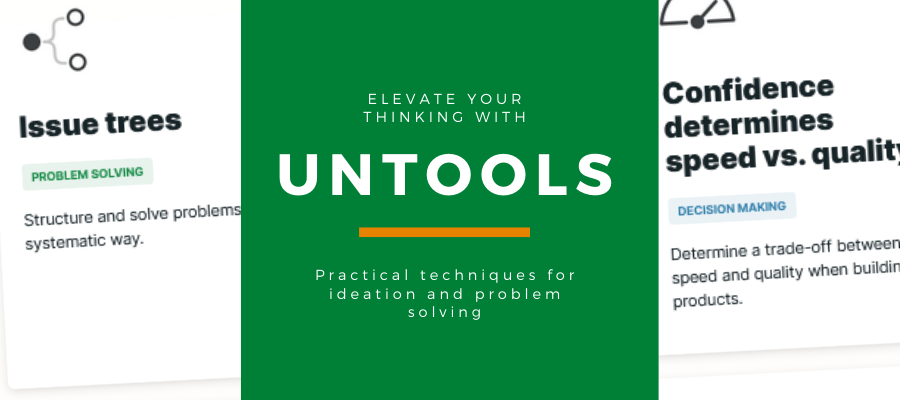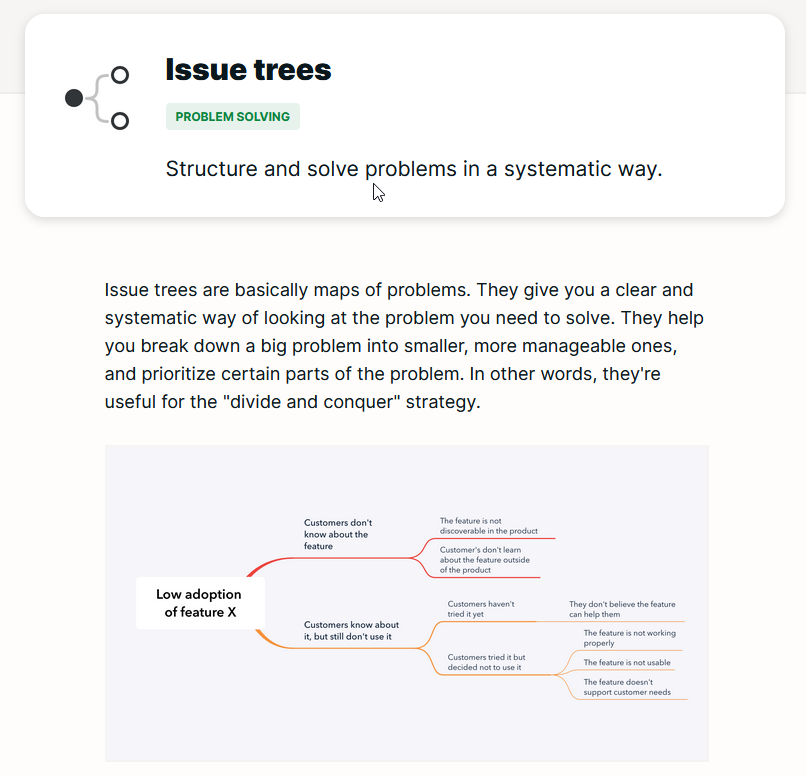
Today’s challenges are more complex than ever. That means we need to elevate our thinking to tackle them. Fortunately, Adam Amran has us covered with his inspiring Untools website, which catalogs powerful frameworks for thinking and problem solving.
Untools describes each thinking technique in detail, but also how to use it and provides an example of it it in action. Amran has published profiles of 13 Untools so far, including first principles, abstraction laddering and the decision matrix, with more on the way.
I recently interviewed him to learn more about the thinking behind this brilliant website and his plans for the future of Untools.
 Chuck Frey: What do you do for a living? What’s your background?
Chuck Frey: What do you do for a living? What’s your background?
Adam Amran: I’m a product designer. I’m self-taught and I’ve been designing apps and websites for over 8 years now.
Frey: Where did you come up with the idea for Untools?
Amran: For a while now, I’ve been looking into improving my thinking. Many designers obsess over digital tools but rarely do I hear anyone discuss thinking tools. While researching these tools, I found that there’s a lot to discover but it’s scattered over the web. Often it’s poorly explained or there’s no focus on practicality. I wanted to build a place to have these tools together.
Frey: What was the trigger event that made you decide, “I really need to create a website devoted to this!“?
Amran: It was actually synergy of a few things. The first one was researching the space of thinking tools. At the same time, I’ve been learning to code. And finally, the lockdown during the pandemic meant I had suddenly lots of free time. So I had an idea about what to build, I knew how to do it and I had the time to do it. That’s when I decided to give it go.
Frey: Why do you call them Untools?
Amran: I actually brainstormed a lot of names before I came up with this. I knew I wanted a name with “tools” in it. At the same time, thinking tools are unlike traditional tools (whether physical or digital), because they’re not as tangible. That’s how I made the connection to call the project “Untools.”
Frey: How did you select the techniques that you have included in the website so far?
Amran: As I was researching the space of thinking tools, I began to see that most tools fall into three categories: problem solving, decision making and system thinking. So I decided to feature these in the project.
Within the categories, I am very picky on which tools to include. The focus is on practicality. Each tool must be practically applicable and simple enough to explain concisely. That’s why I’m not including a lot of what people call “mental models”. That has become an umbrella term for a) descriptive models from various domains (e.g. physics), b) thinking tools and c) mental representations of how stuff works. I only include thinking tools that I see as applicable right away.
Frey: I love how you not only included an explanation of each technique on your site, but also examples and tips on how to use them. Do you think people need help getting over the hump to start using these tools?
Amran: I believe guidance and examples help a lot to see if the tool is right for you. Sometimes the general description can be too vague. Specific instructions and examples can show you what the tool can actually do for you.
This also makes the tool more practical. Guidance and examples are the affordances for thinking tools. They invite for using and show how the tools can be used.

Frey: How do you use creative thinking methods like these in your work? What kind of a difference have they made for you?
Amran: I haven’t used all the tools in the collection yet, to be honest, just a few. But they already helped me think more clearly about certain problems or decisions. They help me to be more methodical and intentional about the problems I’m working on.
Frey: Which thinking technique is your favorite and why?
Amran: I have two favorites: first principles and the hard choice model.
When working on something, understanding the problem thoroughly is essential. First principles thinking allows me to get to the bottom of a problem – to see beyond what’s most visible.
The hard choice model is my favorite decision-making tool. I make a lot of design decisions. Some are more difficult or important than others. This tool helps me see how much effort should go into different decisions.
Frey: Why do you believe that having access to a toolbox of problem-solving techniques is important today?
Amran: The problems we are solving are only getting more complex. I believe it’s not enough to just wing it, that can actually be dangerous. We should be more methodical in our approach to problems. Different tools can make us see problems from different angles, discover layers we didn’t consider and generally make more thoughtful solutions.
Frey: Do you think the need for tools like this has become even stronger in the last six months, considering all of the wrenching changes the world has been going
through?
Amran: I think the need has been there and will be there regardless of events like this. If anything, I believe the need will grow bigger in the future.
Frey: In my 20+ years writing about creative problem solving, i’ve noticed an odd phenomenon: the majority of people don’t believe they need thinking tools. They’re content to simply brute-think their way out of problems. I don’t know: perhaps they think using tools is a sign of weakness? Based on your background and experiences, how would you describe the benefits and advantages that using thinking tools brings to the table?
Amran: The greatest benefit is that these tools allow you to think more logically, to consider problems and decisions more thoroughly and from different angles. We all have biases and thinking tools can help us keep them at bay.
Of course, using these tools means admitting we’re not perfect in our thinking and maybe that’s why some people will be skeptical about it.
If we accept we’re not perfect, these tools can really help. Some of them can give our thinking more structure and (perhaps counter-intuitively) make us more creative.
Creativity isn’t necessarily about having a genius idea pop out of nowhere. Within the constraints and structure that thinking tools provide, we can actually come up with more creative ideas.
Frey: I’ve also discovered that people are, for the most part, very habitual thinkers. They don’t tend to seek out alternate ways of generating ideas and solutions. Why do you think that is?
Amran: People will generally do the least amount of work or make the least amount of effort that’s necessary. Thinking is very energy-consuming for us humans. Habitualizing our thinking saves energy and that’s what we’ve evolved to do.
Frey: Do you believe the problems we need to solve today are more complex and require a higher level of thinking and problem-solving?
Amran: As I already mentioned, yes. The world and its connectedness has grown so much in the last couple of centuries. We are dealing with complex issues and we need a thoughtful approach to deal with them skillfully.
Frey: Are you seeking input from readers of Untools? Do you want them to submit their favorite thinking techniques to you?
Amran: Definitely! I’m more than happy to receive suggestions.
Frey: What’s next for the Untools website? Will you be adding other products and services to it?
Amran: I’m working on adding several new tools right now.
After that, I’ll create some guidance for choosing the right tool. It can be time consuming to learn each tool and whether it can help you in your specific situation. I’m looking into how you can easily choose the right tool from the whole collection.
Frey: Is there anything else the readers of my blog should know about Untools?
Amran: The tools are only useful if you actually apply them. I’d love to see stories of people using them and sharing their experience with what works and what doesn’t.
Explore all of the thinking techniques on the Untools website. View Adam’s personal website and portfolio here and follow his work on Twitter here.
